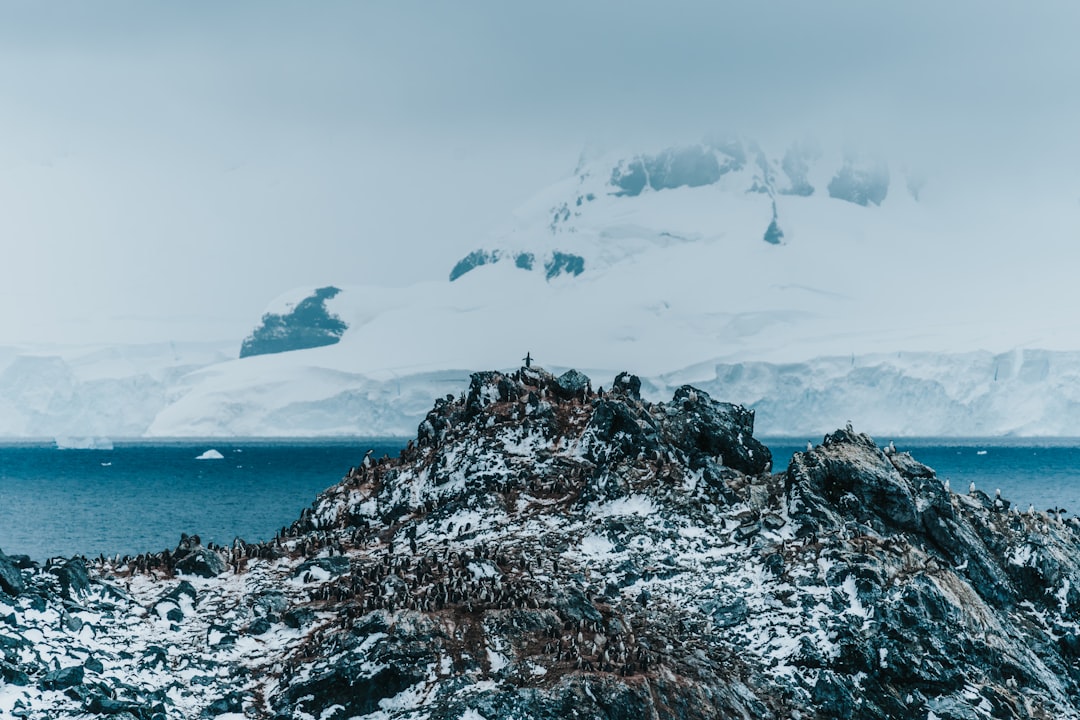The Drake Passage, a body of water situated between the southern tip of South America and Antarctica, is renowned for its tumultuous seas and unpredictable weather. Named after the English explorer Sir Francis Drake, who navigated these waters in the late 16th century, the passage serves as a critical maritime route for vessels traveling to and from the Antarctic region. Stretching approximately 800 kilometers (500 miles) wide, it connects the Atlantic and Pacific Oceans, making it a vital corridor for both commercial shipping and scientific research expeditions.
The passage is not only significant for its geographical position but also for the unique challenges it presents to those who dare to traverse its waters. The Drake Passage is often described as one of the most dangerous stretches of ocean in the world. Its reputation is built on a combination of fierce winds, towering waves, and rapidly changing weather conditions that can turn a calm sea into a raging tempest in a matter of hours.
For adventurers and researchers alike, the allure of the passage lies in its raw beauty and the promise of discovery, but it also demands respect and caution.
Key Takeaways
- The Drake Passage is a body of water between South America’s Cape Horn and the South Shetland Islands of Antarctica, known for its turbulent seas and unpredictable weather.
- Treacherous weather conditions in the Drake Passage include strong winds, high waves, and rapidly changing weather patterns, making it one of the most challenging maritime routes in the world.
- The passage has a history of shipwrecks and disasters, with many vessels succumbing to the harsh conditions and treacherous waters over the centuries.
- The passage’s impact on wildlife and ecosystems is significant, with strong currents and upwelling bringing nutrients to the surface, supporting a diverse range of marine life.
- Modern-day explorers and researchers face numerous challenges when navigating the passage, including extreme weather, limited access to emergency services, and the psychological toll of the journey.
The treacherous weather conditions
The weather conditions in the Drake Passage are notoriously volatile, characterized by strong winds that can reach speeds of over 60 knots and waves that can soar to heights of 30 feet or more. This combination creates a chaotic environment that can be both exhilarating and terrifying for those on board. The passage is influenced by the confluence of several ocean currents, including the Antarctic Circumpolar Current, which contributes to its rough seas.
As a result, vessels navigating these waters must be equipped to handle extreme conditions that can arise suddenly and without warning. Moreover, the passage experiences frequent storms that can last for days, further complicating navigation. The cold air from Antarctica collides with warmer air from the north, creating a breeding ground for severe weather systems.
These storms can lead to reduced visibility, heavy rain, and even snow, making it difficult for crews to maintain course and ensure the safety of passengers. For many sailors, the unpredictability of the weather in the Drake Passage serves as both a challenge and a reminder of nature’s power.
Historical shipwrecks and disasters

The treacherous nature of the Drake Passage has led to numerous shipwrecks and maritime disasters throughout history. One of the most infamous incidents occurred in 1914 when Ernest Shackleton’s ship, the Endurance, became trapped in pack ice while attempting to reach Antarctica. The crew faced harrowing conditions as they battled freezing temperatures and treacherous seas for months before ultimately being rescued.
This story has become emblematic of human endurance in the face of nature’s fury and highlights the risks associated with navigating these perilous waters. Another notable disaster took place in 1989 when the cruise ship M.S. Explorer sank after hitting an iceberg in the Drake Passage.
The incident resulted in a dramatic rescue operation involving nearby vessels and helicopters, showcasing both the dangers of this maritime route and the importance of preparedness in emergency situations. These historical events serve as stark reminders of the Drake Passage’s reputation as a graveyard for ships and underscore the need for modern navigational strategies to mitigate risks.
Impact on wildlife and ecosystems
| Category | Impact |
|---|---|
| Deforestation | Loss of habitat for wildlife |
| Pollution | Contamination of water and soil, harming ecosystems |
| Climate Change | Disruption of ecosystems and migration patterns |
| Overfishing | Decline in fish populations and imbalance in marine ecosystems |
Despite its treacherous reputation, the Drake Passage is home to a rich diversity of marine life and ecosystems that thrive in its cold waters. The nutrient-rich currents support an array of species, including krill, which serves as a vital food source for larger animals such as whales, seals, and seabirds. The passage acts as a critical feeding ground for these creatures, particularly during migration seasons when they travel to and from breeding grounds in Antarctica.
However, the harsh conditions of the Drake Passage also pose challenges for wildlife. The extreme weather can disrupt feeding patterns and migratory routes, impacting populations of marine animals. Additionally, climate change poses an increasing threat to these ecosystems as rising ocean temperatures alter food availability and habitat conditions.
Researchers are closely monitoring these changes to understand their implications for wildlife in the region and to develop strategies for conservation efforts.
Challenges for modern-day explorers and researchers
Modern-day explorers and researchers face a unique set of challenges when navigating the Drake Passage. While advancements in technology have improved safety measures, the unpredictable nature of the weather remains a significant concern. Researchers often embark on expeditions with specific scientific goals in mind, but they must remain flexible and adaptable as conditions change rapidly.
This requires not only technical skills but also strong teamwork and communication among crew members. Furthermore, logistical challenges abound when planning expeditions to this remote region. Accessing supplies, ensuring vessel readiness, and coordinating with various stakeholders can be daunting tasks.
Researchers must also consider environmental regulations aimed at protecting fragile ecosystems while conducting their studies. Balancing scientific inquiry with environmental stewardship is crucial for ensuring that future generations can continue to explore and learn from this remarkable area.
Strategies for navigating the passage safely

To navigate the Drake Passage safely, modern explorers employ a variety of strategies designed to mitigate risks associated with its treacherous conditions. One key approach involves thorough preparation before setting sail.
By understanding weather patterns and currents, crews can make informed decisions about when to embark on their journey. Additionally, vessels are equipped with state-of-the-art navigation systems that enhance safety during transit. These systems provide real-time data on sea conditions, allowing crews to adjust their course as needed.
Training is also essential; crew members undergo rigorous safety drills to prepare for emergencies that may arise during their voyage. By fostering a culture of safety and preparedness, modern explorers can increase their chances of successfully navigating the challenges posed by the Drake Passage.
The psychological toll on passengers and crew
The psychological toll of traversing the Drake Passage can be significant for both passengers and crew members alike. The uncertainty of weather conditions combined with the physical discomfort associated with rough seas can lead to heightened anxiety levels among those on board. Passengers may experience seasickness or fear during turbulent moments, while crew members must remain focused on their responsibilities despite potential stressors.
Moreover, long periods spent at sea can lead to feelings of isolation or cabin fever among passengers and crew alike. Maintaining morale becomes crucial during challenging voyages; thus, crews often implement strategies to foster camaraderie among passengers through group activities or shared meals. By creating a supportive environment onboard, they can help alleviate some of the psychological burdens associated with navigating this formidable passage.
Emergency response and rescue operations
Given its reputation for danger, emergency response protocols are critical when traversing the Drake Passage. Vessels operating in these waters are required to have comprehensive emergency plans in place to address potential incidents such as medical emergencies or equipment failures. Crew members undergo extensive training in emergency response procedures to ensure they are prepared for any situation that may arise.
In addition to onboard preparedness, coordination with nearby vessels and rescue organizations is essential for effective response efforts. The remote nature of the Drake Passage means that assistance may not always be readily available; therefore, having contingency plans in place is vital for ensuring passenger safety. Successful rescue operations depend on clear communication channels between vessels operating in the area and rapid mobilization of resources when emergencies occur.
The role of technology in mitigating risks
Technology plays an increasingly important role in mitigating risks associated with navigating the Drake Passage. Advanced satellite communication systems allow crews to stay connected with meteorological services for real-time updates on weather conditions. This information enables them to make informed decisions about their route and timing while at sea.
Additionally, innovations in vessel design have led to improved stability and safety features that enhance performance in rough waters. Modern ships are equipped with stabilizers that reduce rolling motion during turbulent conditions, providing greater comfort for passengers while minimizing risks associated with capsizing or losing control. As technology continues to evolve, it holds promise for further enhancing safety measures in this challenging maritime environment.
The allure of the passage for adventure seekers
Despite its dangers, the Drake Passage remains an irresistible draw for adventure seekers from around the globe. For many travelers, crossing this notorious stretch of water represents a rite of passage—a testament to their spirit of exploration and willingness to embrace uncertainty. The thrill of navigating such treacherous waters is often accompanied by breathtaking views of icebergs, wildlife sightings, and stunning landscapes that make every moment worthwhile.
Adventure tourism has flourished in recent years as more people seek unique experiences beyond traditional vacation destinations. Expeditions through the Drake Passage offer opportunities for wildlife encounters, scientific learning experiences, and personal growth through overcoming challenges at sea. For those who dare to embark on this journey, it promises not only adventure but also a deeper connection with nature’s raw beauty.
The future of Antarctic exploration and the Drake Passage
As interest in Antarctic exploration continues to grow, so too does awareness regarding environmental conservation efforts within this fragile ecosystem. The Drake Passage will undoubtedly play a pivotal role in shaping future research initiatives aimed at understanding climate change impacts on marine life and ecosystems. Collaborative efforts between scientists, governments, and conservation organizations will be essential for ensuring sustainable practices are upheld during expeditions.
Moreover, advancements in technology will likely enhance safety measures while providing new avenues for exploration within this remote region. As researchers develop innovative tools for studying marine environments—such as autonomous underwater vehicles or advanced monitoring systems—the potential for groundbreaking discoveries increases exponentially. In conclusion, while traversing the Drake Passage presents numerous challenges—from treacherous weather conditions to psychological tolls—its allure remains undeniable for adventurers seeking unique experiences at sea.
As explorers continue to navigate these waters with respect for both nature’s power and its delicate ecosystems, they contribute not only to our understanding of this remarkable region but also pave the way toward responsible exploration practices that honor its significance for generations to come.
The Drake Passage, a notorious stretch of water between the southern tip of South America and Antarctica, is infamous for its treacherous conditions. This perilous passage is characterized by strong currents, unpredictable weather, and massive waves, making it one of the most challenging maritime routes in the world. For those interested in understanding more about the geographical and environmental factors contributing to the Drake Passage’s danger, a related article can be found on MyGeoQuest. This article delves into the unique oceanographic and meteorological conditions that make the Drake Passage so formidable. You can read more about it by visiting MyGeoQuest.
WATCH NOW! Drake Passage: Earth’s Deadliest Waters Revealed
FAQs
What is Drake Passage?
Drake Passage is the body of water between the southern tip of South America and the northern tip of the Antarctic Peninsula. It connects the Atlantic and Pacific Oceans.
Why is Drake Passage so dangerous in Antarctica?
Drake Passage is known for its rough seas and strong winds, making it one of the most treacherous stretches of water in the world. The convergence of the Atlantic, Pacific, and Southern Oceans creates intense weather patterns, including powerful storms and high waves.
What are the specific dangers of Drake Passage?
The main dangers of Drake Passage include extreme weather conditions, rough seas, strong winds, and the potential for icebergs. These factors make navigation and travel through the passage challenging and hazardous.
How do these dangers impact travel to Antarctica?
The dangerous conditions in Drake Passage can make travel to Antarctica difficult and risky. Ships crossing the passage may experience rough seas, leading to discomfort and potential safety concerns for passengers and crew.
Are there any safety measures in place for crossing Drake Passage?
Ships crossing Drake Passage often have experienced captains and crew who are familiar with the challenging conditions. Additionally, modern technology and navigation systems are used to help mitigate the risks associated with the passage.
Are there alternative routes to reach Antarctica?
While Drake Passage is the most direct route to reach Antarctica from South America, there are alternative routes such as traveling through the Indian Ocean and around the southern tip of Africa. However, these routes may also present their own challenges and are typically longer in duration.
